| Author |
Message |
Morgan Butler

|
 Posted: Tue 15 Apr, 2008 1:01 pm Post subject: New Spadroon arrives! Happy day! Posted: Tue 15 Apr, 2008 1:01 pm Post subject: New Spadroon arrives! Happy day! |
 |
|
My new/old Spadroon arrived, a Model 1796. Compared to my Model 1786 it is an inch longer (a little over 32 inches) and somewhat broader. The balance really inspires one to throw cuts at an opponent. Even though it has been called "the perfect impediment" people did fight with it. I think in new issue condition it would hold a parry and deal a nasty wound to face, neck and hands and as a thrusting implement it would have excellent stopping power. As a gentlemans traveling weapon it would be perfect. Beefy , not ungainly but fencable. It would handle like a short transitional rapier. The grip fills my hand nicely.
On the con side, the dealer said the folding guard would stay fixed in the combat position but it does not. I became philosophical about this once I noticed how flimsy and delicate the soft brass shell/butterfly guards are. One solid whack from an infantry hanger or cavalry sabre would cave them in immediatley.
On the whole I quite like the look and feel of it. It catches the light nicely. The hilt is about 96 percent tight. I took off the tape he used to hold the silver foil down on the grip and applied a clear apoxy on the underside that keeps it secure. In the way that one sword can be a reflection of other swords, it brings to my mind a Marlbourogh era british cavalry broadsword, except of course it isnt. Heres a pic of the 1796 and the 86
 Attachment: 78.04 KB Attachment: 78.04 KB
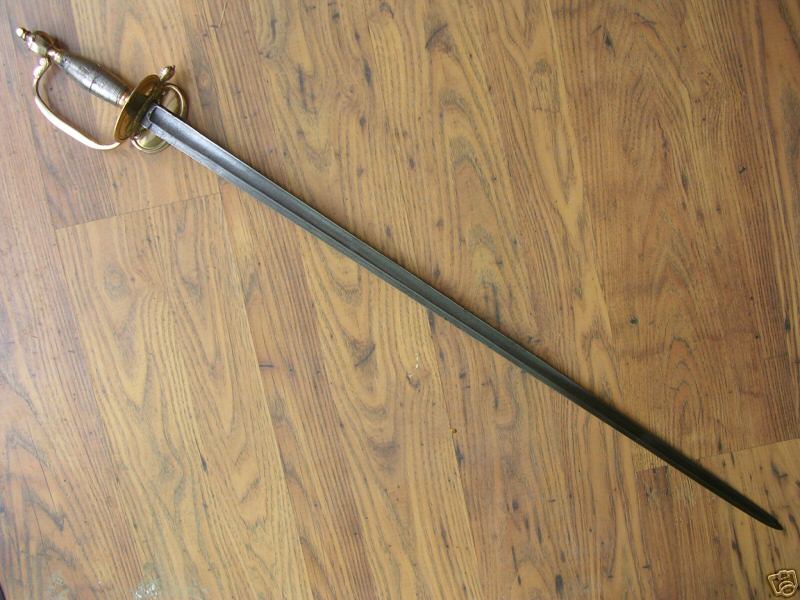
 Attachment: 58.47 KB Attachment: 58.47 KB
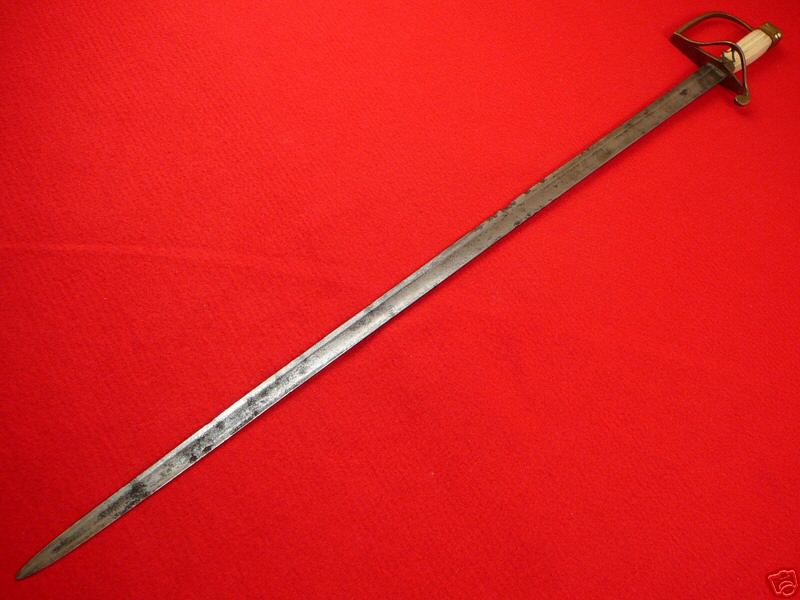
inkothemgard!
|
|
  |
 |
Nathan Robinson
myArmoury Admin


|
|
    |
 |
Morgan Butler

|
 Posted: Tue 15 Apr, 2008 3:17 pm Post subject: Posted: Tue 15 Apr, 2008 3:17 pm Post subject: |
 |
|
Here is all the pics I have from the seller. I will have to take some of my own later. The guards are rather flimsy and you could bend them in with your hands alone.
 Attachment: 98.09 KB Attachment: 98.09 KB
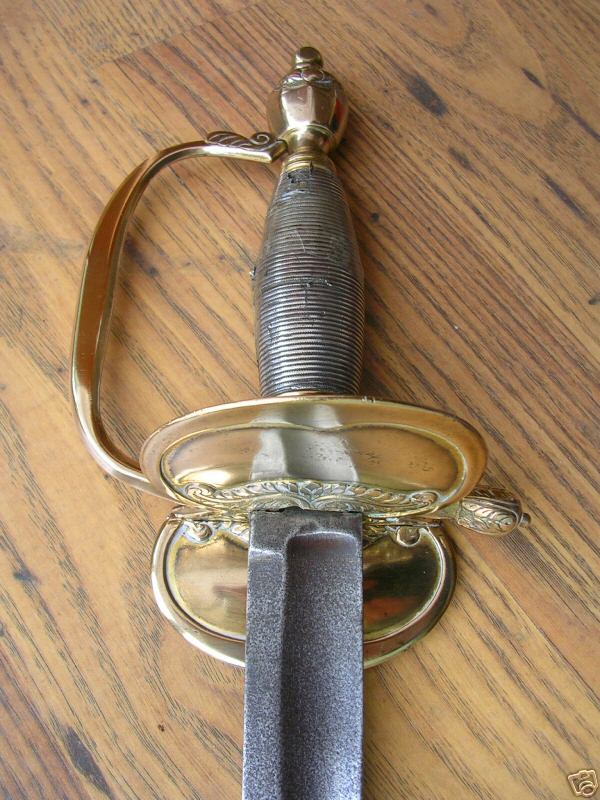
 Attachment: 90.19 KB Attachment: 90.19 KB
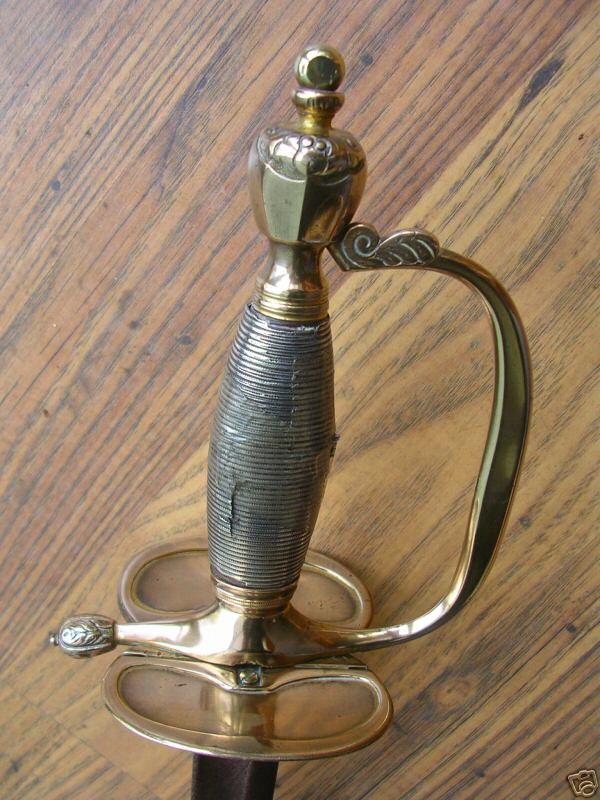
inkothemgard!
|
|
  |
 |
Morgan Butler

|
 Posted: Tue 15 Apr, 2008 3:18 pm Post subject: Posted: Tue 15 Apr, 2008 3:18 pm Post subject: |
 |
|
Really the mechinisim is just a pin thru the hinges and nothing more. I know some spadroons had "combat locks" which was a hook on a swivel that kept the guard in place.
inkothemgard!
|
|
  |
 |
|
Jonathan Hopkins
|
 Posted: Tue 15 Apr, 2008 3:20 pm Post subject: Posted: Tue 15 Apr, 2008 3:20 pm Post subject: |
 |
|
Here are some photos of the hinged section on my Pattern 1796 Infantry Officer's Sword. I hope they are helpful!
Jonathan
PS--Congrats on the new sword, Morgan! 
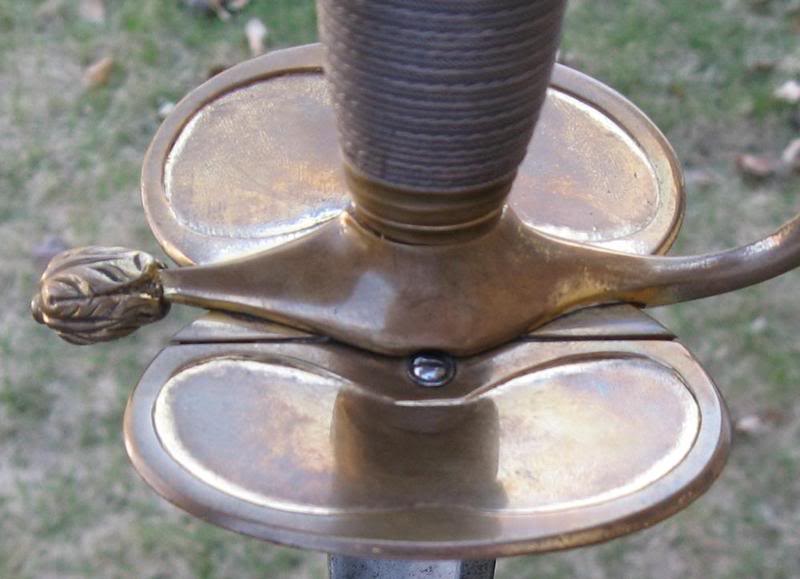
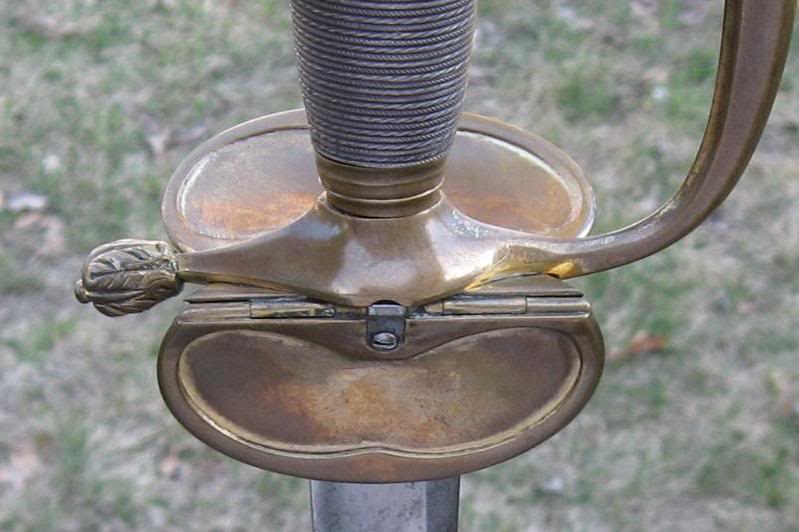

|
|
  |
 |
|
Doug Lester
Location: Decatur, IL Joined: 12 Dec 2007
Posts: 167
|
 Posted: Tue 15 Apr, 2008 6:33 pm Post subject: Posted: Tue 15 Apr, 2008 6:33 pm Post subject: |
 |
|
|
Morgan, I guess I need a little enlightenment here. Personally, I rather like the visual appearance of the Spadroon. On what basis was this sword considered "the perfect impediment"? I don't have any references that realy talk about the Spadroon, but I think that I read somewhere that it was favored by British naval officers, though from what you said about your swords, they don't seem particularly short and more suited to close quarter fighting. Was this prejudice based on some characteristic of the weapon or was it mearly that it wasn't a rapier or a smallsword?
|
|
  |
 |
|
Jonathan Hopkins
|
 Posted: Tue 15 Apr, 2008 7:08 pm Post subject: Posted: Tue 15 Apr, 2008 7:08 pm Post subject: |
 |
|
According to Robson (Swords of the British Army, 1996) the Pattern 1796 Infantry Officer's Sword was "regarded with much contempt by its wearers." Its hilt was seen as inadequate as it was relatively fragile. On p.146 Robson cites General Mercer who recalled:
| Quote: | | Nothing could be more useless or more ridiculous than the old Infantry regulation [sword]; it was good neither for cut or thrust and was a perfect encumbrance. In the Foot Artillery, when away from headquarters, we generally wore dirks instead of it. |
Still, it is an attractive sword!
Jonathan
|
|
  |
 |
D Critchley

|
 Posted: Wed 16 Apr, 2008 5:04 am Post subject: Posted: Wed 16 Apr, 2008 5:04 am Post subject: |
 |
|
Mercer was of course Artillery not Line infantry for which the pattern was intended, so one needs to view his words with caution, especially when Sir John Moore (of Corunna fame) recommends a light straight thrusting sword for officers.
The pattern in a number of minor variations is used in Britain, Russia and Prussia from about 1750, so it can't have been that useless.
The hinged guard usually works with a leaf spring that is rivetted to the tang which rises through the grip to play against the hinge, but again there are other interpretations. The hinged guard (despite what Withers in his book claims) is not part of the regulations, simply a popular cutler's improvement.
David
David C
"The purpose of the cavalry on the battlefield is to give tone to an event that otherwise might be considered a common brawl"
|
|
  |
 |
|
Jonathan Hopkins
|
|
  |
 |
|
Doug Lester
Location: Decatur, IL Joined: 12 Dec 2007
Posts: 167
|
 Posted: Wed 16 Apr, 2008 6:48 am Post subject: Posted: Wed 16 Apr, 2008 6:48 am Post subject: |
 |
|
|
Thanks for all the info. From what I've read in these posts it seems that the criticism of the spadroon has been based on one person's opinion and referes mainly to one model of the sword, the 1796 British infantry model. Another question, what makes a sword a spadroon? What are it's defining characteristics?
|
|
  |
 |
|
Jonathan Hopkins
|
 Posted: Wed 16 Apr, 2008 7:23 am Post subject: Posted: Wed 16 Apr, 2008 7:23 am Post subject: |
 |
|
We talked a bit about the definition in this thread, and more can be found here. I think of it as a straight blade in the 30"-32" range, that is approximately 1" wide at the ricasso, and that can cut and thrust. This blade can be found with a number of different hilt arrangements, but are commonly found with stirrup hilts, five-ball hilts, boatshell hilts, slot hilts, and bilobate hilts such as that of the P1796.
Jonathan
|
|
  |
 |
Morgan Butler

|
 Posted: Thu 17 Apr, 2008 9:56 am Post subject: Posted: Thu 17 Apr, 2008 9:56 am Post subject: |
 |
|
Jonathan, thanks for all those thread links. They were really interesting! I am working on the Carlo Parisi article right now.
I agree with you, my idea of the weapon is a light, straight, backsword in most instances.
I am developing a liking for the spadroon. now that I own two. I wish I still had my M. 1796 Heavy cavalry dress sword for it handled rather like a double edged spadroon. I think the only critiscisim is that the guards are flimsy/dinky/useless. I myself would prefer the earlier non-folding guard. And perhaps a more substantial construction. You would probably need to make the pommel a little heavier to balance it all out.
It seems that thecriticisim about the spadroon is what we remember most, but really there are only a few instances that we cite. I guess that we should recall all the all the articles on how to use it and also recall the thousands of officers who probably did actually fight with it in battle. (At least on the Sharpe series. lol.) There is an American Historical Fighting Arts group that apparently does use them but I have had no luck finding them or getting access to their site. I would be interested in learning to what extent and to what satisfaction the Royal Navy used them as battle weapons.
A very interesting point that was brought up in another thread was that the Spadroon was designed for the Gentleman with specific fencing/smallsword training who wanted to use that technique in a battlefield scenario against heavier weapons. I really like that idea and find it likely. I also think it has great value as a civilian traveling sword that one could fence with in non-formal unexpected encounters.
inkothemgard!
|
|
  |
 |
Morgan Butler

|
 Posted: Thu 17 Apr, 2008 11:23 am Post subject: Posted: Thu 17 Apr, 2008 11:23 am Post subject: |
 |
|
It comes to my mind that if I were going to use a spadroon or wear one with the intention or possibility of engaging in combat, I would wear a nice, stout dagger as well. This isnt any reference to a particular period but just in reference to me. However in the 18th and early 19th century I'm sure it wasnt unheard of for an officer to go into action with spadroon and naval dirk. Hell, I may have to think about getting a custom spadroon made, suitable for combat. One with a decent hilt. It could go with my custom 18th century european officers double edged broadsword. I
inkothemgard!
|
|
  |
 |
Glen A Cleeton

|
 Posted: Thu 17 Apr, 2008 12:13 pm Post subject: Posted: Thu 17 Apr, 2008 12:13 pm Post subject: |
 |
|
I don't know that practicing spadroon technique was the real world context of what became sabre fencing but they do receive mentiion in a few articles. This one comes up in most of my searches on the subject.
http://www.1911encyclopedia.org/Sabre-fencing
Of note might be the Italian use of the words spadone and spadrone. That article relates the type to be a light broadsword. It also discusses singlestick quite a bit in relation to sabre fencing and although probably quite a parallel practice in the 19th century, might be perceived a better ancestor of sport sabre fencing than general combined backsword and smallsword technique. I am not a schooled fencer but do definitely look to both those genre as applicable to spadroon play. Some i would like to share a drink or two with while discussing this would be Paul Macdonald, Bob Brooks, Milo Thurston, etc. from the UK that have devoted time and practice to understanding fencing and freeplay with spadroons.
What we typically seem to think of as a spadroon blade does vary some in width but invariably seems to incorporate a sharpened false edge. It is not unreasonable to look at the evolution of the blade type for military use as being meant capable of more shearing type cuts while retaining the ability to slash with both edges of the blade's tip.
The fixed guard spadroons of the 1796 type do often seem a bit sturdier as well. David has posted some examples of what appear to be NCO examples and a somewhat interesting paralell is the U.S. use of a simliar pattern for NCOs during the American Civil War. Although, it is easily arguable that the U.S. pattern is derivative of the French military swords, the blade is pure spadroon albeit a bit narrower.
The slotted hilts varied from flimsy to sturdy as well. Here is my slotted hilt and although brass is probably sturdy enough to take quite a bit of punishment.


While still unable to place this one exactly in history, it is apparent that the general style lasted for some time. This one would apparently not be out of place anywhere from the 1780s to as late as 1820. Splitting the difference, i typically introduce it as somewhere around 1800 with additional caveats of information I have been offered regarding it.
It is my favorite of three to grab and flourish. Though, a bit of an ugly duckling from an aesthetic standpoint. My eagle pommel seems quite dead comparatively but has a showy appeal to go with a sturdy blade. My French dressy piece is very agile but truly more of smallsword calibre albeit conforming somewhat to what gets listed as spadroons.
Cheers
GC
|
|
  |
 |
Morgan Butler

|
 Posted: Thu 17 Apr, 2008 1:21 pm Post subject: Posted: Thu 17 Apr, 2008 1:21 pm Post subject: |
 |
|
I really like that spadroon! I dont think its an ugly duckling at all. The solid hilt is very nice, is it iron or brass? How long is it.?
inkothemgard!
|
|
  |
 |
Glen A Cleeton

|
 Posted: Thu 17 Apr, 2008 4:56 pm Post subject: Posted: Thu 17 Apr, 2008 4:56 pm Post subject: |
 |
|
| Morgan Butler wrote: | | I really like that spadroon! I dont think its an ugly duckling at all. The solid hilt is very nice, is it iron or brass? How long is it.? |
It is brass, or some brass alloy. The blade is 32" long and 1 3/16" wide at the guard. Here is the old dealer picture (nice folks) and a couple more of my shots. The grip likely had a foil wrap but that is long gone, as it is on many examples. Some gilt remains on the hilt and in the blade engravings which inculde an officer gesculating as if to say, "Those fellows, over there. Do take care of them now". The engravings also include a GR and crown.
Cheers
GC
|
|
  |
 |
D Critchley

|
 Posted: Fri 18 Apr, 2008 4:34 am Post subject: Posted: Fri 18 Apr, 2008 4:34 am Post subject: |
 |
|
Based on the officer's hat Glen nearer 1780 than 1800
David
David C
"The purpose of the cavalry on the battlefield is to give tone to an event that otherwise might be considered a common brawl"
|
|
  |
 |
Glen A Cleeton

|
 Posted: Fri 18 Apr, 2008 7:57 am Post subject: Posted: Fri 18 Apr, 2008 7:57 am Post subject: |
 |
|
| D Critchley wrote: | Based on the officer's hat Glen nearer 1780 than 1800
David |
 Yes, I tend to think of it that way too. You had shared a nice illustration when I first aquired the piece and I have been a bit remiss in not following up with better research about British officers in general. There are a few factors that do seem to place it earlier than later. Yes, I tend to think of it that way too. You had shared a nice illustration when I first aquired the piece and I have been a bit remiss in not following up with better research about British officers in general. There are a few factors that do seem to place it earlier than later.
A piece with similar figural engravings. A limo of a spadroon. A horseman's sword. One of many I'd probably buy if having unlimited resources. This one is over on Gun Broker.
Cheers
GC
Last edited by Glen A Cleeton on Fri 18 Apr, 2008 8:13 am; edited 1 time in total
|
|
  |
 |
|
Jonathan Hopkins
|
 Posted: Fri 18 Apr, 2008 8:11 am Post subject: Posted: Fri 18 Apr, 2008 8:11 am Post subject: |
 |
|
This seller lists everything as a cavalry sword! 
This spadroon is a spadroon and not a dragoon or cavalry weapon. At 31” it falls within the normal range for an infantry sword blade. The officer who carried it might have been mounted at times, but that does not make it a dragoon’s sword. 
Jonathan
|
|
  |
 |
Glen A Cleeton

|
 Posted: Fri 18 Apr, 2008 8:23 am Post subject: Posted: Fri 18 Apr, 2008 8:23 am Post subject: |
 |
|
| Jonathan Hopkins wrote: | This seller lists everything as a cavalry sword! 
|
And royal archer swords as artillery, naval as infantry etc To be fair, I worded my post kind of badly and have edited it to reflect this is a spadroon. A clip of his description below.
| Quote: | | depicts old form of GR in script, topped by crown and under it an arms spray, opposite side exhibits figure of British officer in plumed dragoon helmet, buckskin frontier jacket with fringes on sleeves and seams, shoulder eppaulettes, tight pants, cravat and sash and calf high mocassins holding his word as if it were a cane in a foppish pose with lapels, |
He does have some interesting stuff and will apparently haggle.
I had really just posted it as a neato and another example of figural engraving.
Cheers
GC
Last edited by Glen A Cleeton on Fri 18 Apr, 2008 8:29 am; edited 1 time in total
|
|
  |
 |
|
|

